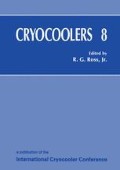Abstract
Two Ricor K506B Stirling cycle cryocoolcrs with H-10 control electronics were used on the Clementine spacecraft, one cooling a 256 × 256 InSb infrared detector for the near-infrared (NIR) camera and the other cooling a 128 × 128 HgCdTe focal plane array on the longwave infrared (LWIR) camera. This is the first use of these Ricor Stirling cryocoolers in a space environment. This mission has demonstrated the use of these Clementine lightweight imaging sensors in the demanding environment of space, and and has space-qualified this Ricor cryocooler. Moreover, nearly the entire 38 million square kilometers of the Moon’s surface was mapped in 11 spectral bands, six in the near-infrared, during the 71 days of lunar mapping. The more than 1.6 million digital images collected are providing mineral typing scientific data to the international civilian scientific community.
The NIR cryocooler operated successfully for a total of 840 hours with 361 on/off cycles. The H-10 electronics provided good focal plane array (FPA) temperature control with a typical operating FPA temperature of 70.3 K and a one-sigma variation of 0.46 K. The thermal environment for the cooler ranged from −23.7°C to 38.2°C.
The Ricor cryocooler used on the LWIR camera performed the same during the Clementine mission as it did on the ground. This cryocooler ran for a total of 670 hours with 359 on/off cycles. The H-10 electronics were not able to provide FPA temperature control. This inability to operate at a fixed set point is believed to be caused by a ground difference between the H-10 controller electronics and the FPA temperature sense diode. The FPA temperature varied in proportion to the cryocooler (heat reject) temperature. The FPA temperature during imaging varied from 66.9 K to > 85 K. The thermal environment for this cooler ranged from −22.1°C to 41.0°C.
Three additional Ricor K506B cryocoolers are currently operating in life test at LLNL and are within nominal performance parameters. These have operated for approximately 3000 hours in a thermal vacuum environment over temperatures ranging from −16°C to 30°C.
Access this chapter
Tax calculation will be finalised at checkout
Purchases are for personal use only
Preview
Unable to display preview. Download preview PDF.
Author information
Authors and Affiliations
Editor information
Editors and Affiliations
Rights and permissions
Copyright information
© 1995 Springer Science+Business Media New York
About this chapter
Cite this chapter
Priest, R.E., Robinson, J.A., Clark, T.L., Hadley, D.R., Sewall, N.R. (1995). Ricor K506B Cryocooler Performance during the Clementine Mission and Ground Testing: A Status Report. In: Ross, R.G. (eds) Cryocoolers 8. Springer, Boston, MA. https://doi.org/10.1007/978-1-4757-9888-3_86
Download citation
DOI: https://doi.org/10.1007/978-1-4757-9888-3_86
Publisher Name: Springer, Boston, MA
Print ISBN: 978-1-4757-9890-6
Online ISBN: 978-1-4757-9888-3
eBook Packages: Springer Book Archive

